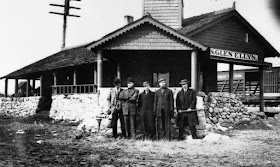Moses Stacy, a soldier in the War of 1812, arrived here in 1835. DuPage County, Illinois was founded in 1839. Moses' inn, "Stacy's Tavern," was built in 1846 and his second home, was a halfway stop between Chicago and the Fox River Valley and a probable stop for Galena-Chicago Frink & Walker’s General Stage Coach line on their way to Rockford, Illinois. [Stacy's Tavern historical monument stands at what is now the intersection of Geneva Road and Main Street.]
 |
| The Stagecoach wasn't as glamorous as the movies made them out to be. |
 |
| 1855 Railway Guide Showing Danby, Illinois, in Red. |
The first church, a Congregational church, was built in 1862. Many Protestant churches were built in the village in the years to come. It wasn't until 60 years later that the first Catholic church was built.
The name Glen Ellyn had been adopted by 1889, when village president Hill and businessman Philo Stacy spearheaded a project to create a new lake, called Lake Glen Ellyn (today’s Lake Ellyn), by having a dam built in a nearby stream. The current Glen Ellyn is based on the Welsh version of the name of the then–village president Thomas E. Hill's wife Ellen, preceded by glen, referring to the local geography.
 |
| The Great Western Railroad built a freight station in 1888 on the south side of the track just west of Main Street in Glen Ellyn. |
 |
| The Glen Ellyn Hotel opened in 1893 for the summer season, with prices ranging from $2.00 to $3.00 per day. After the hotel changed hands several times, in the summer of 1905 it was occupied as a free hospital supported by the Chicago Tribune Company. The next summer the building remained unoccupied and on May 1, 1906 was struck by lightening and completely destroyed by fire. |
The village's all-volunteer fire department was created in 1907. By the end of the 20th century, it was the last all-volunteer fire department in DuPage County. By World War I, Glen Oak Country Club served the Oak Park and Glen Ellyn communities.
Compiled by Neil Gale, Ph.D.

Like many places in the country, things were named after settlers, stage coach and eventually railroads. Every place on the railroad required a name. Right here in Merrillville, I also have Lottaville and Rexville.
ReplyDeleteFurther east, Ainsworth, Sedley, and eventually Valparaiso Indiana.
Amazing story. So many things we would not know without your research. Tha
ReplyDeletenks Neil.
The railroad map shows the town of Lodi which is now Maple Park. Blackberry appears to be where the town of Elburn is today.
ReplyDelete